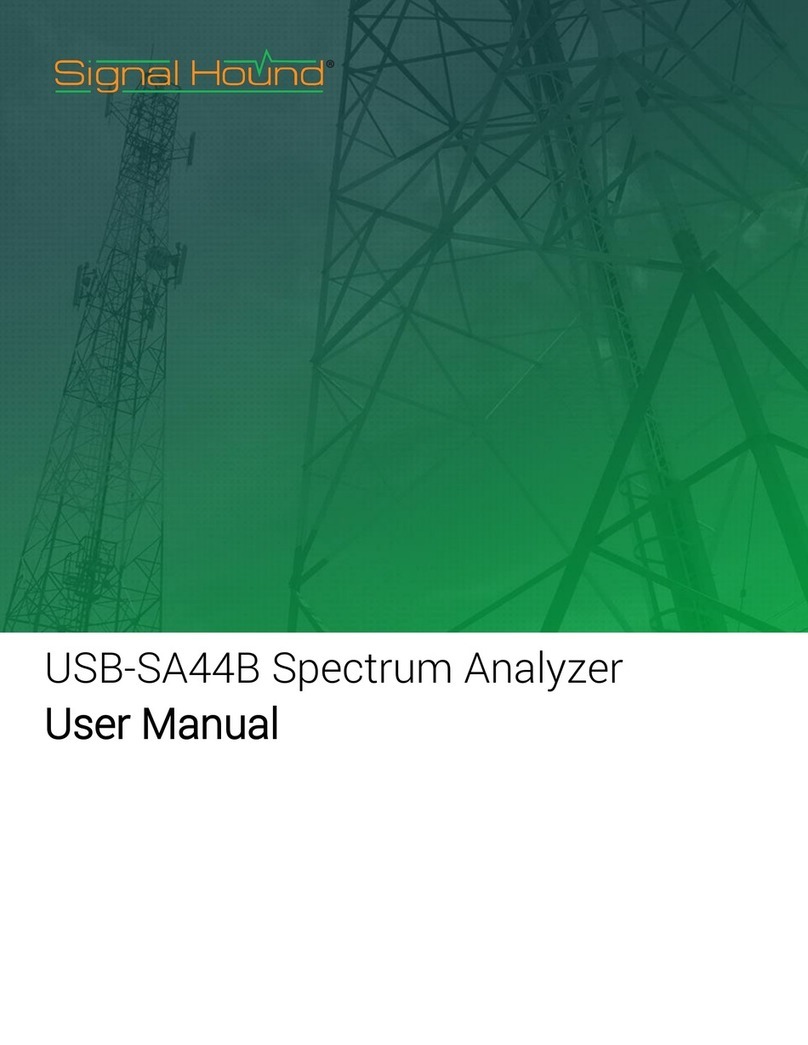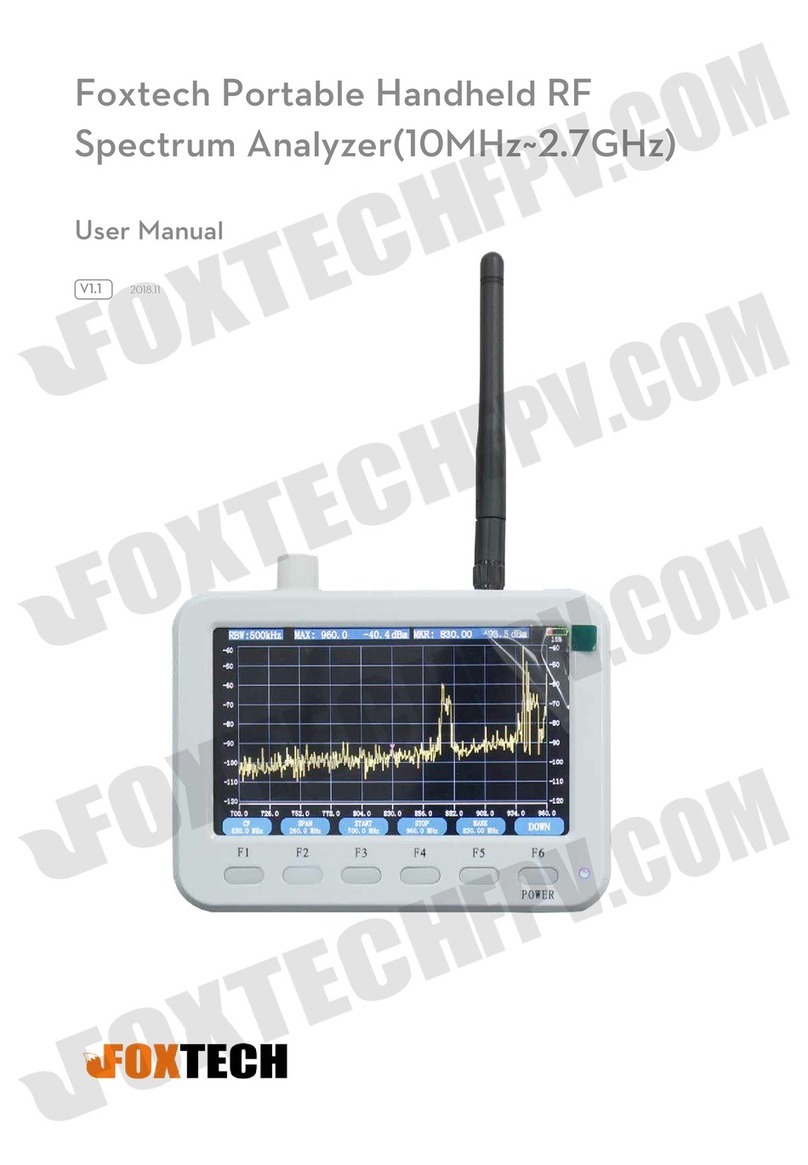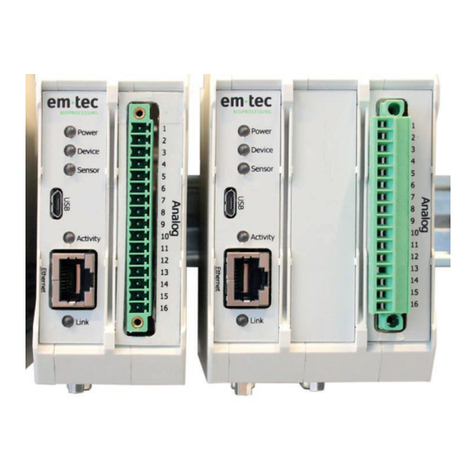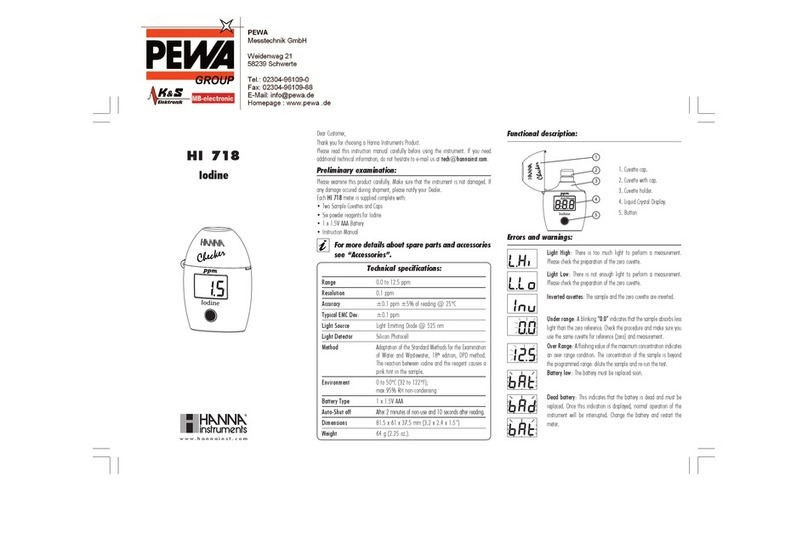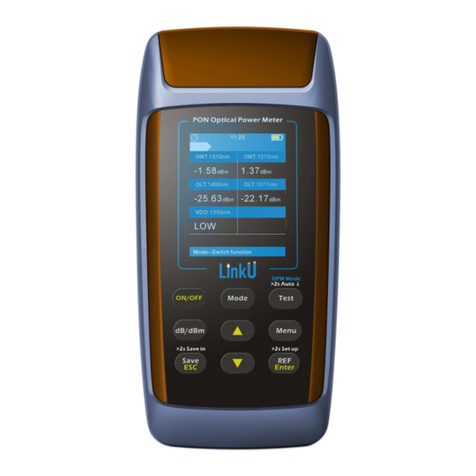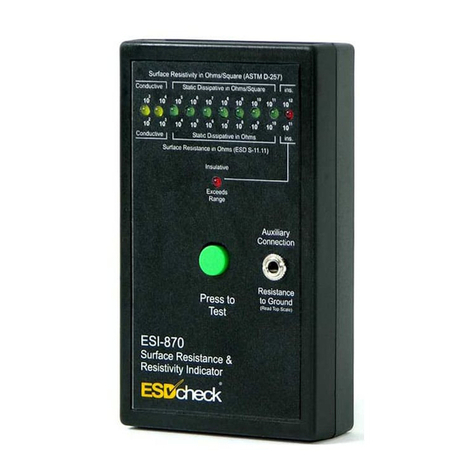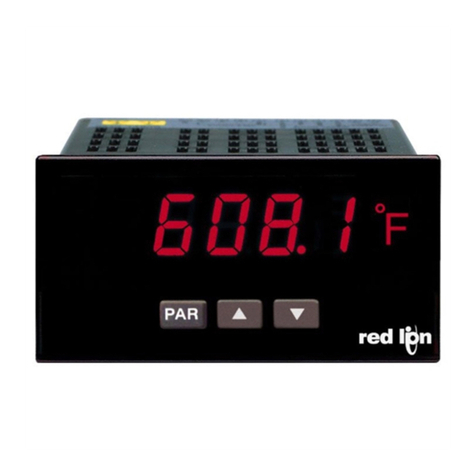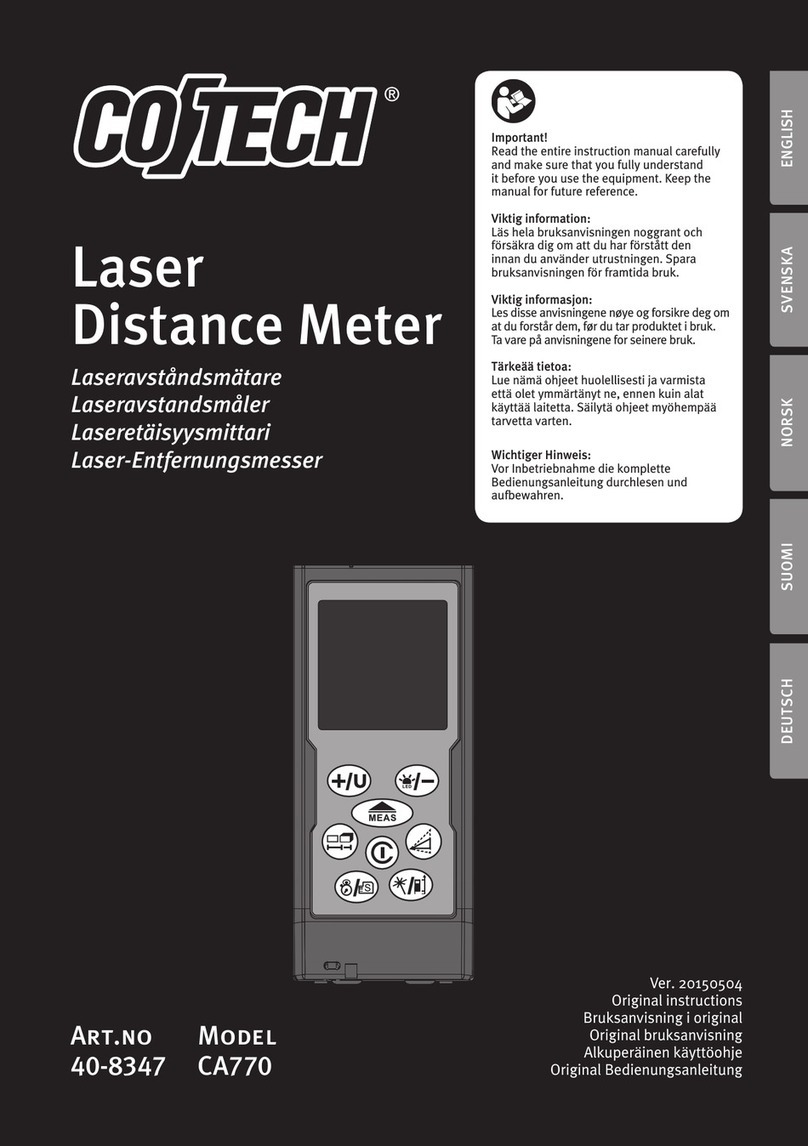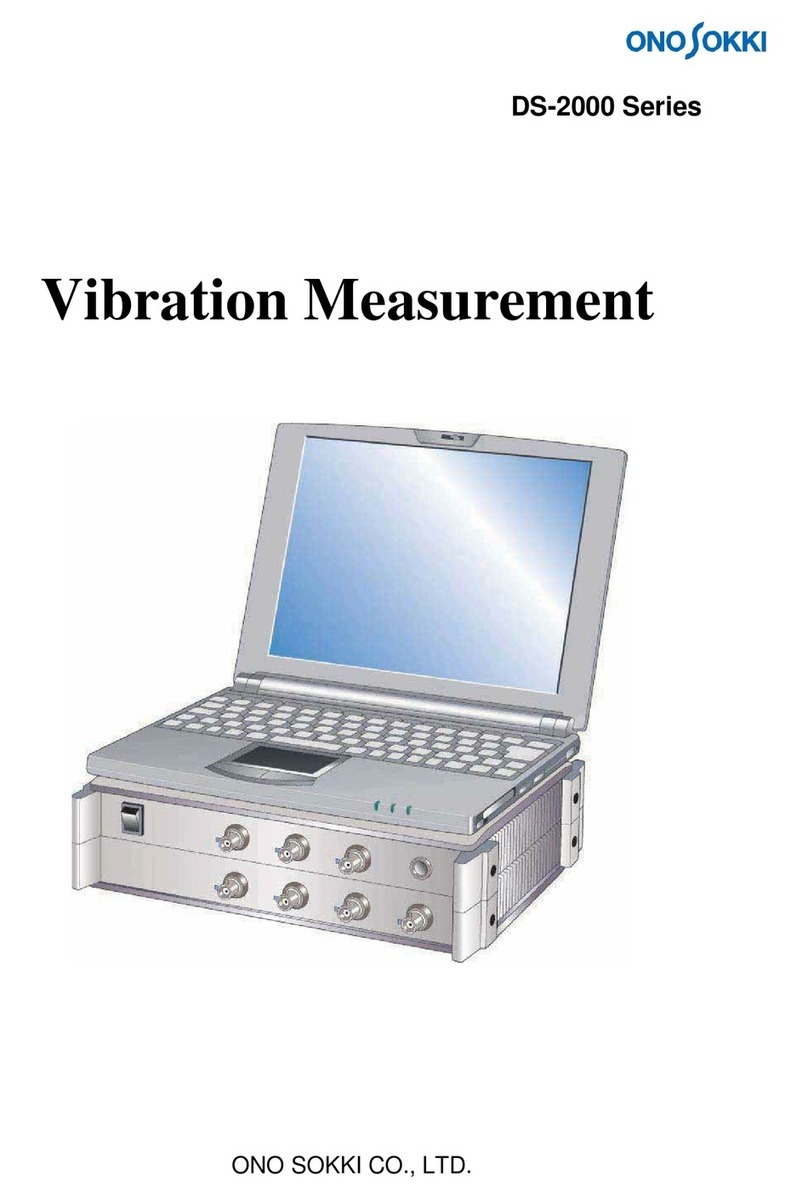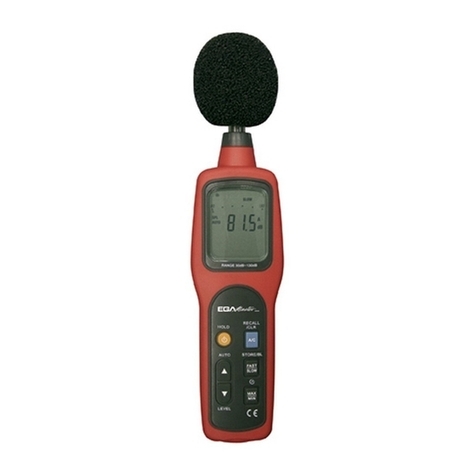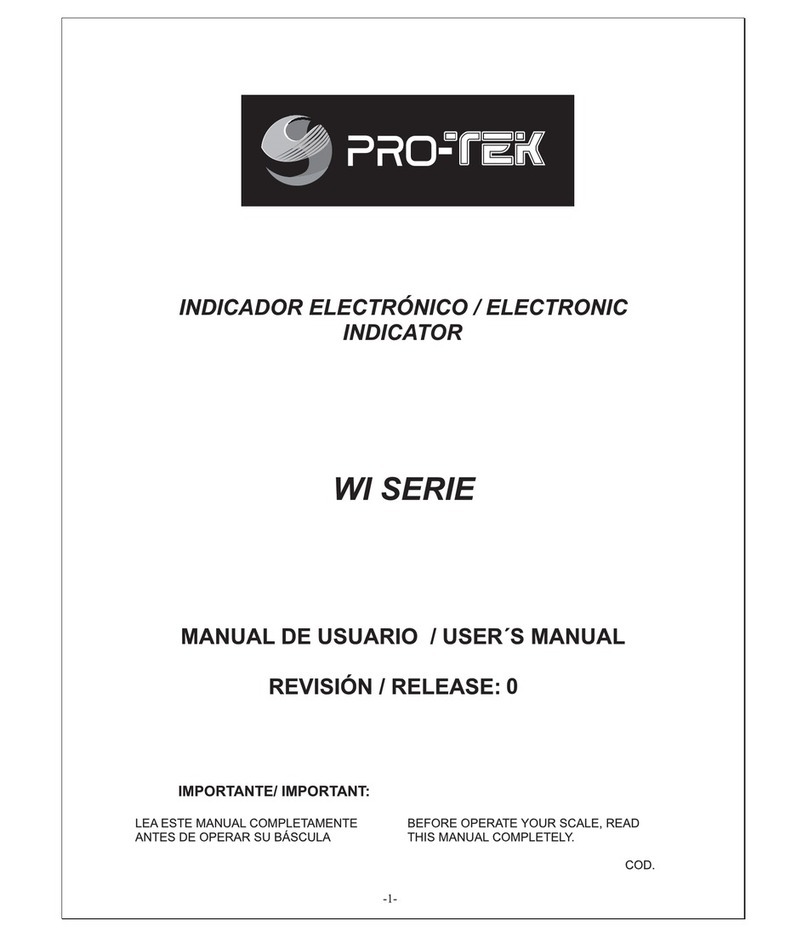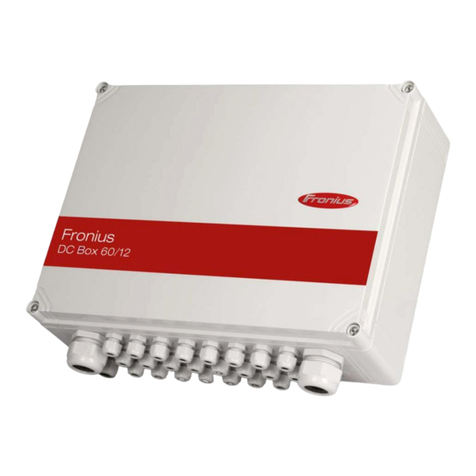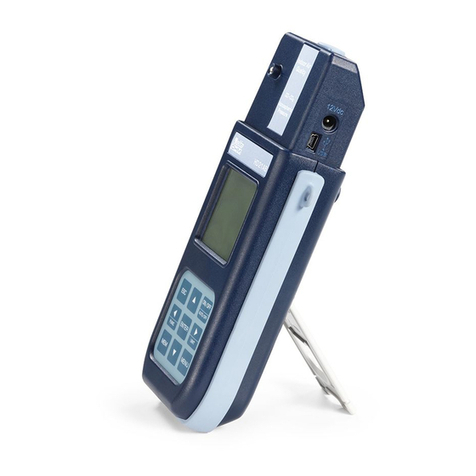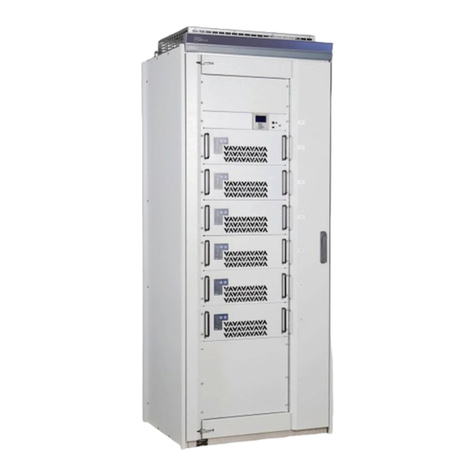Signal Hound BB60D User manual

BB60D Spectrum Analyzer
Product Manual

ii
Signal Hound BB60D User Manual
Published 6/14/2022
ã2022, Signal Hound
1502 SE Commerce Ave, Suite 101
Battle Ground, WA
Phone 360-313-7997
This information is being released into the public domain in accordance with the Export Administration
Regulations 15 CFR 734

iii
Contents
1 Overview ........................................................................................................................................................... 4
2 Preparation ....................................................................................................................................................... 4
3 Understanding the BB60D Hardware ............................................................................................................. 7
4 Troubleshooting ............................................................................................................................................. 10
5 Calibration and Adjustment .......................................................................................................................... 11
6 BB60D Preliminary Specifications ............................................................................................................... 11
7 Warranty and Disclaimer ............................................................................................................................... 13
8 Appendix ......................................................................................................................................................... 14

Overview
|What’s New
4
1 Overview
This document outlines the operation and functionality of the BB60D Signal Hound spectrum
analyzer. This document will help you understand the capabilities, performance specifications,
and features of your BB60D.
1.1 What’s New
The BB60D is a significant improvement over the BB60C. The BB60D has a preselector, better
dynamic range, better phase noise, and lower residual spurious signal levels. The BB60D has a
dedicated 10 MHz input and additional digital output options.
2 Preparation
The BB60D is a real-time high-speed spectrum analyzer communicating with your PC over a USB
3.0 Super Speed link. It has 27 MHz of real-time bandwidth, tunes from 9 kHz to 6 GHz, collects
80 million samples per second, and streams data to your computer at 140 MB/sec. By adding a
high-speed hard drive to your PC or laptop (250 MB/s sustained write speed), the BB60D doubles
as an RF recorder, streaming up to 80 million IF samples per second, or 40 million I/Q samples
to disk.
2.1 Initial Inspection
Check your package for shipping damage before opening. Your box should contain a USB 3.0 Y-
cable, a CD-ROM, and a Signal Hound BB60D.
2.2 Software Installation
See the Spike Software manual for installation instructions. You must have administrator
privileges to install the software. During installation, the BB60 device drivers will also be installed.
It is recommended to install the application folder in the default location.
2.2.1 Software Requirements
Supported Operating Systems
• Windows 7/8/10 – Supports 64 and 32-bit, (64-bit recommended) *
• Ubuntu Linux 18.04 – Supports 64-bit
Minimum System Requirements

Preparation
|Connecting Your Signal Hound
5
• Processor – 3rd generation or newer Intel dual/quad core i-series processors***
• 8 GB RAM - 1 GB for the BB60 software
• Native USB 3.0 support†
Recommended System Requirements
• Windows 7 64-bit or Ubuntu Linux 18.04 64-bit
• Processor - 3rd generation or newer Intel desktop quad-core i-series processors***
• 8 GB RAM - 1 GB for the BB60 software
• Native USB 3.0 support†
• OpenGL 3.0 capable graphics processor**
(* We do not recommend running the BB60D in a virtual machine (i.e. Parallels/VMWare/etc.))
(** Certain display features are accelerated with this functionality, but it is not required.)
(***Our software is optimized for Intel CPUs. We recommend them exclusively.)
(† Early USB 3.0 controllers from Renesas and ASMedia do not function well with our BB60.
Native USB 3.0 hardware is used to refer to Intel’s USB 3.0 controllers found on 3rd generation
or newer i-series processors.)
2.3 Connecting Your Signal Hound
With the software and BB60 drivers installed, you are ready to connect your device. Plug in both
the male USB 3.0 and male USB 2.0 connections into your PCs respective USB ports, and then
plug the USB 3.0 Micro-B male connection into the BB60 device. Your PC may take a few seconds
recognizing the device and installing any last drivers. Wait for this process to complete before
launching the Spike software.
2.3.1 Option 10
For option 10, external 5V input, plug in the USB cable before your external power supply (not
included). To power down, unplug the external power before the USB cable.
2.4 The BB60 Front and Rear Panels
The front panel includes a 50Ω SMA RF Input. Do not exceed +20 dBm or damage may occur.
A READY/BUSY LED flashes from green to orange each time a command from the computer is
processed.
The rear panel has three connectors:
1. 10 MHz Reference input (SMA). Use a clean 10 MHz reference sine wave or square wave
with >0 dBm level. A +13 dBm sine wave input or 3.3V CMOS clock input is recommended.
2. A USB 3.0 Micro-B female connector. Use the Y-cable provided to connect the device to
your PC.

Preparation
|The BB60 Front and Rear Panels
6
3. A multi-purpose SMA connector for signal I/O, primarily for trigger input, including GPS 1
pulse per second (PPS) trigger, and external trigger in zero span mode. May also be used
as a general purpose 3.3V logic output, to send UART commands, or to output a 10 MHz
signal.
The BB60D is a hybrid superheterodyne-FFT spectrum analyzer with preselector. The BB60D
uses a local oscillator and band-pass filters to convert a portion of the input spectrum into an
intermediate frequency (IF). The intermediate frequency is then sent from the device to the host
PC where it undergoes FFT spectrum analysis transforming the input IF into a frequency
spectrum. The resulting IF contains 27MHz of usable bandwidth.
The BB60D is also a real-time spectrum analyzer. This means the device is capable of
continuously streaming the IF frequency with no time gaps. Having no time gaps is critical for
measurements and tests requiring high probability of intercept (POI). See the section below Real-
Time Spectrum Analysis for a more in-depth discussion of the BB60 capabilities.
The BB60D offers multiple modes of operation, available in both our Spike software and API. See
the Spike software manual and BB60 API manuals for more information
When paired with a USB-TG44A, or a USB-TG124A, the BB60D may be used as a scalar network
analyzer. See the Spike software manual for more information. The BB60D is not recommended
for scalar network analysis measurements below 100 kHz.

Understanding the BB60D Hardware
|Front End Architecture
7
3 Understanding the BB60D Hardware
3.1 Front End Architecture
3.2 Description
The BB60D is a two-stage superheterodyne receiver, using two independent intermediate
frequencies (IF), selected based on RF input frequency. Three separate methods are used to
minimize second-order intermodulation products, depending on frequency range. Below 30 MHz,
a high linearity, low noise operational amplifier is used, from 30-130 MHz a push-pull amplifier is
used, and above 130 MHz a sub-octave preselector is used. The IF frequencies used are 2380
MHz and 1220 MHz.

Understanding the BB60D Hardware
|Description
8
Intermediate Frequency (IF) used for each range of RF frequencies
RF Frequency Range (MHz)
IF Frequency (MHz)
LO Frequency Range (MHz)
30-1810
2380
2410-4190
1810-4210
1220
3030-5430
4210-5590
2380
6630-8000
5590-6000
1220
6800-7220
Gain control is achieved in the BB60D using the front-end attenuator and RF gain control. The
front end was designed to provide good IP2, IP3, noise figure, and intermodulation and spurious-
free dynamic range for frequencies within its operating range. Care was taken to preserve
dynamic range as reference level is adjusted, but dynamic range will degrade slightly when
reference level exceeds +0 dBm.
The BB60D achieves maximum sensitivity at a reference level of -30 dBm, 20 dB higher than the
BB60C. Residual spurious signals at maximum sensitivity are typically below -120 dBm, meaning
the noise floor stays clean even at a 1 kHz RBW.
The 14-bit ADC uses built-in dithering to further improve the linearity and decrease spurious
responses from the ADC. Spurs from the ADC are typically 70 dB below the carrier.
From the ADC, digitized IF data is handed off to an FPGA where it is packetized. The Cypress
FX3 peripheral controller streams the packetized data over a USB 3.0 link to the PC, where 80
million, 14-bit ADC samples per second are processed into a spectrum sweep or I/Q data stream.
The intermediate frequency is filtered out of the RF for every band, but spurious typically below -
60 dBc may be observed from input frequencies of 1220±10 MHz, 2380±10 MHz, and 1190±5
MHz.
Shielding has been improved to reduce residual spurious signals to a minimum.

Understanding the BB60D Hardware
|Scalloping Loss
9
3.3 Scalloping Loss
An FFT-based spectrum analyzer uses digital resolution bandwidths rather than discrete analog
filters. Moving from analog to digital introduces some new terms important to measurement
accuracy, like FFT bins, window functions, spectral leakage and scalloping loss. To sum up, an
FFT produces an array of discrete frequency bins and their associated amplitude. Real-world
signals rarely line up exactly with a single frequency bin, which can result in some ugly behavior
unless a window function is used. Many different window functions are available, with various
strengths and weaknesses.
For the BB60, swept modes default to a flat top window, which offers excellent amplitude flatness
and therefore very little scalloping loss, in exchange for a wider resolution bandwidth and longer
processing time. Most RBWs used by the BB60 are from flat top windows, so scalloping loss is
negligible.
In real-time mode a Nuttall window function is used, which has a narrower bandwidth to reduce
processing time and level out impulse response. However, when a signal falls halfway between
two “bins,” the energy is split between adjacent bins such that the reported “peak” amplitude may
be lower by as much as 0.8 dB.
To get an accurate CW reading using “Marker peak”, flat top RBW shape in swept mode is
recommended.
In either mode, the “channel power” utility, which integrates the power across any channel
bandwidth you specify, also eliminates this scalloping loss, giving you a full accuracy amplitude
reading even in real-time mode.
3.4 Dynamic Range
Dynamic range has many definitions, but one common definition in spectrum analysis is
intermodulation-free dynamic range (IMFDR), 2/3(TOI – DANL), normalized to a 1 Hz RBW.
At 1 GHz, -10 dBm reference level, the TOI is typically +15 dBm, and DANL is typically -141 dBm
(1 Hz RBW). Dynamic range, 2/3 (TOI – DANL) = 104 dB.
At any reference level, 0 dBm or below, the front end attenuator will be the sole source of gain
control, and as reference level changes, both TOI and DANL change by roughly the same amount,
keeping dynamic range fairly constant. At a +10 dBm reference level, the RF gain cannot be set
for optimum dynamic range, and this number will be a few dB lower.

Troubleshooting
|Protecting the BB60D RF Input
10
3.5 Protecting the BB60D RF Input
The BB60D’s input attenuator and front end switches can be damaged by ESD above 1.5 kV
HBM, and have a damage level just above +20 dBm peak (not RMS). Some common events
which may lead to front end damage include:
1) Applying more than +20 dBm peak power, such as an antenna exposed to a radar pulse.
2) ESD from a passive antenna, either from discharge to an antenna element, or from
connecting a large antenna or cable which has built up a static charge.
3) Long term exposure to frequencies below 1 MHz and above +12 dBm may cause
attenuator damage
For any application which may expose the BB60D to front end damage, including connecting to
antennas or power amplifiers, a coaxial limiter is required to protect the input.
A limiter will protect against overpowering the input, typically raising the damage level above 2
watts, as well as offering significant protection against ESD.
Generally, the performance at low input signal levels is just the insertion loss of the limiter, but at
high signal levels there will be some nonlinearity and the resulting intermodulation products. A
typical limiter will have an IP3 around +30 dBm, so for input signals below -10 dBm there should
be little to no effect on linearity.
4 Troubleshooting
If you experience a problem with your Signal Hound, please try these troubleshooting techniques
before contacting us.
4.1 Unable to Find or Open the Device
Ensure the device is plugged in and the LED is on. If it is not, unplug then plug in the device until
it mates completely. Once the LED turns on, use the File menu to try to connect the device again.
4.1.1 A Power Cycle Does Not Fix the Problem
If a power cycle still does not allow you to connect the device, it is possible the device drivers
were not successfully installed. See the Driver Installation section for information about the
BB60 drivers.

Calibration and Adjustment
|The Device is Not Valid
11
4.2 The Device is Not Valid
In the event the device ceases to operate or becomes corrupted, the application might tell you
the device does not appear to be valid. Before contacting us, attempt to power cycle the device
and restart your computer to ensure nothing else is causing this issue. If the issue persists, please
contact us.
5 Calibration and Adjustment
Calibration software is available for the BB60D at no charge, but requires specialized equipment
normally only found in calibration labs. Contact Signal Hound for more information regarding
calibration software and required equipment, or to schedule a calibration.
6 BB60D Preliminary Specifications
The following preliminary specifications are based on being in the Preset condition, using internal
time base, video processing set for average and power, plus VBW, sweep, gain, and attenuation
in the default auto mode. Preliminary specifications are subject to change without notice.
Frequency range
9 kHz to 6 GHz
Streaming Digitized I/Q
4 kHz to 27 MHz of selectable IF bandwidth that is
amplitude corrected
Resolution Bandwidths
(RBW)
1 Hz to 10 MHz
Internal Timebase Accuracy
± 1 ppm per year
Sweep Speed (RBW ≥30 kHz)
24 GHz/sec
Amplitude (RBW ≤100 kHz)
Range: +10dBm to Displayed Average Noise Level (DANL)
Absolute
Accuracy
± 2.0 dB (Non-Native(Flattop)
RBWs)
+ 2.0 dB/-2.6 dB (Native(Nuttall)
RBW’s – faster DSP)
RF Input VSWR at tuned
frequency
≤ 3.0:1 typical (<10 dB attenuation)

BB60D Preliminary Specifications
|The Device is Not Valid
12
≤ 1.5:1 typical (≥10 dB attenuation)
LO Leakage at RF Input
-80 dBm
Displayed Average Noise
Level (DANL)*
Input Frequency Range
dBm/Hz
9 kHz to 500 kHz
-140
500 kHz to 30 MHz
-154
30 MHz to 6 GHz
-158 + 1.1dB/GHz
Residual Responses*
-120 dBm (ref Level ≤ -30 dBm, 0 dB Attenuation)
Spurious Mixer Responses*
-50dBc
(any ref level from 0dBm to -30dBm, in 5dB increments,
input signal 10 dB below ref level, and ≤30kHz RBW)
IP2 *
IP3 *
30-130 MHz: +36 dBm (ref Level = -10 dBm)
<30 MHz, >130 MHz: +50 dBm (ref Level = -10 dBm)
+10 dBm (ref Level = -10 dBm)
SSB Phase Noise at 1 GHz
Center Frequency*
Offset Frequency
dBc/Hz
100 Hz
-80
1 kHz
-90
10 kHz
-93
100 kHz
-97
1 MHz
-117
Recommended Computer
Windows® 7 or 8 operating system or Ubuntu Linux 18.04,
8 GB of RAM, Intel i7, 3rd generation (Ivy Bridge) or later
with a quad core processor, one USB 3.0 port, and one
adjacent USB 2.0 or USB 3.0 port.
Note: RF recording using streaming I/Q bandwidths > 8 MHz
requires the computer’s mass storage drive to have at least
250MB/sec of sustained write speed such as an SSD,
RAID-0, or RAID-5.
Synchronization (≤ 20 MHz
IBW)
1 PPS GPS input port enables ± 50ns time-stamping

Warranty and Disclaimer
|Warranty
13
Operating Temperature
32°F to 149°F (0°C to +65°C) Standard;
-40°F to 149°F (-40°C to +65°C) for Option-1
Weight
Net, 1.10 lbs. (0.50 kg)
Size
8.63” x 3.19” x 1.19” (219mm x 81mm x 30mm)
Power
(1) USB 3.0 port and (1) adjacent USB 2.0 or USB 3.0 port
Approx. 6 watts active, 1 watt idle.
Control and Communication
Option 10 Input Voltage
USB 3.0 serial bus
4.75V – 5.25V, <200 mVpp ripple.
*DANL, Residual Responses, Spurious Mixer Responses, and Phase Noise specifications apply
only at 20°C to 25°C.
** IP2 and IP3 typical performance specifications can be found in the Appendix: Typical
Performance Characteristics of the BB60D.
7 Warranty and Disclaimer
©2013-2022 Signal Hound. All rights reserved.
Reproduction, adaptation, or translation without prior written permission is prohibited, except as
allowed under the copyright laws.
7.1 Warranty
The information contained in this manual is subject to change without notice. Signal Hound makes
no warranty of any kind with regard to this material, including, but not limited to, the implied
warranties or merchantability and fitness for a particular purpose. Signal Hound shall not be liable
for errors contained herein or for incidental or consequential damages in connection with the
furnishing, performance, or use of this material. This Signal Hound product has a warranty against
defects in material and workmanship for a period of two years from date of shipment. During the
warranty period, Signal Hound will, at its option, either repair or replace products that prove to be
defective.

Appendix
|Warranty Service
14
7.2 Warranty Service
For warranty service or repair, this product must be returned to Signal Hound. The Buyer shall
pay shipping charges to Signal Hound and Signal Hound shall pay UPS Ground, or equivalent,
shipping charges to return the product to the Buyer. However, the Buyer shall pay all shipping
charges, duties, and taxes, to and from Signal Hound, for products returned from another country.
7.3 Limitation of Warranty
The foregoing warranty shall not apply to defects resulting from improper use by the Buyer, Buyer-
supplied software or interfacing, unauthorized modification or misuse, operation outside of the
environmental specifications for the product. No other warranty is expressed or implied. Signal
Hound specifically disclaims the implied warranties or merchantability and fitness for a particular
purpose.
7.4 Exclusive Remedies
The remedies provided herein are the Buyer’s sole and exclusive remedies. Signal Hound shall
not be liable for any direct, indirect, special, incidental, or consequential damages, whether based
on contract, tort, or any other legal theory.
7.5 Certification
Signal Hound certifies that, at the time of shipment, this product conformed to its published
specifications.
7.6 Credit Notice
Windows® is a registered trademark of Microsoft Corporation in the United States and other
countries.
Intel® and Core™ are trademarks or registered trademarks of the Intel Corp. in the USA and/or
other countries.
Ubuntu® is a registered trademark of Canonical, Ltd. in the United States and/or other countries.
8 Appendix
8.1 Typical Performance Characteristics of the BB60D
Below are characteristics of the BB60D which have shown to be typical. These are not hard
specifications but show the typical performance in a few aspects not covered in our official specs.

Appendix
|Typical Performance Characteristics of the BB60D
15
The official BB60D device specifications can be found in this document under the section titled
BB60D Specifications.
8.1.1 Third Order Intercept (TOI)
Typical IIP3 at Specified Reference Level (dBm) Gain and Atten
= AUTO
Freq(GHz)
R.L. = -30
-20
-10
0
1
-4.5
5.5
15.5
25.5
2.5
-4.8
5.2
15.2
25.2
4
-4.0
6.0
16.0
26.0
5.5
-1.0
9.0
19.0
29.0
8.1.2 Second Order Intercept
Typical IIP2 at Specified Reference Level (dBm) Gain and Atten
= AUTO
Freq(GHz)
R.L. = -30
-20
-10
0
1
45.7
55.7
65.7
75.7
2.5
46.2
56.2
66.2
76.2
4
43.1
53.1
63.1
73.1
5.5
42.0
52.0
62.0
72.0

Appendix
|Typical Performance Characteristics of the BB60D
16
8.1.3 Typical Displayed Average Noise Level (-30 dBm R.L.)
-166
-165
-164
-163
-162
-161
-160
-159
-158
-157
0123456
Noise Floor (dBm/Hz)
Frequency (GHz)
Table of contents
Other Signal Hound Measuring Instrument manuals
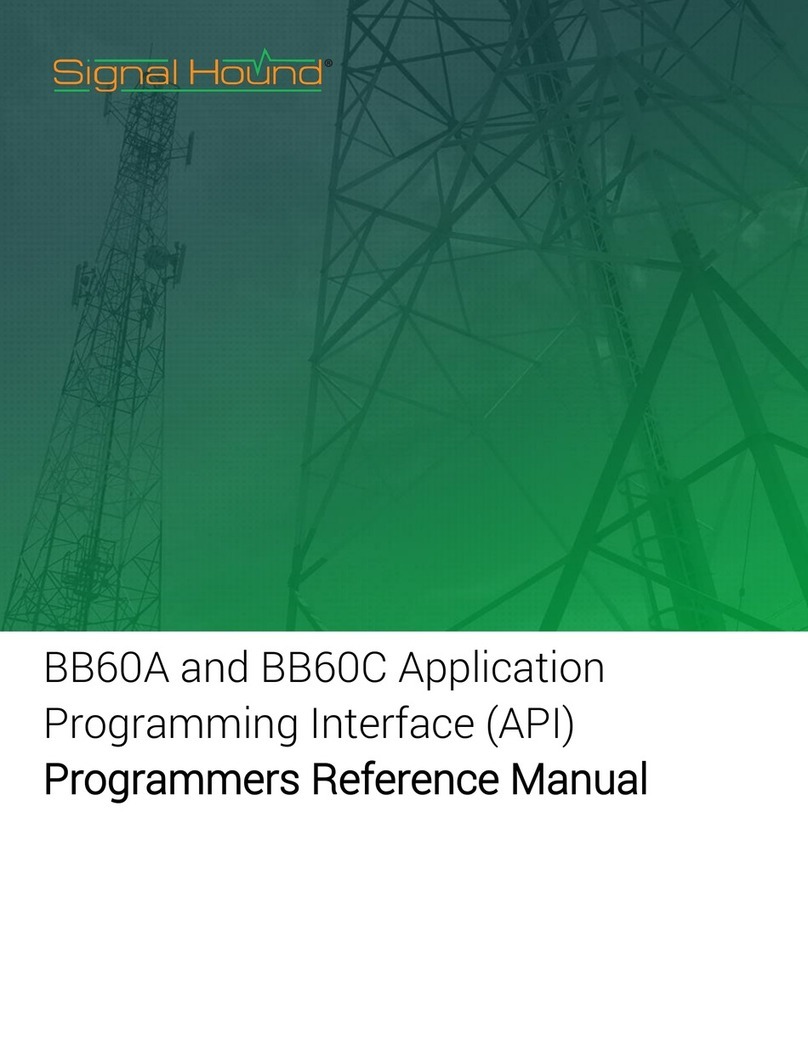
Signal Hound
Signal Hound BB60C User manual
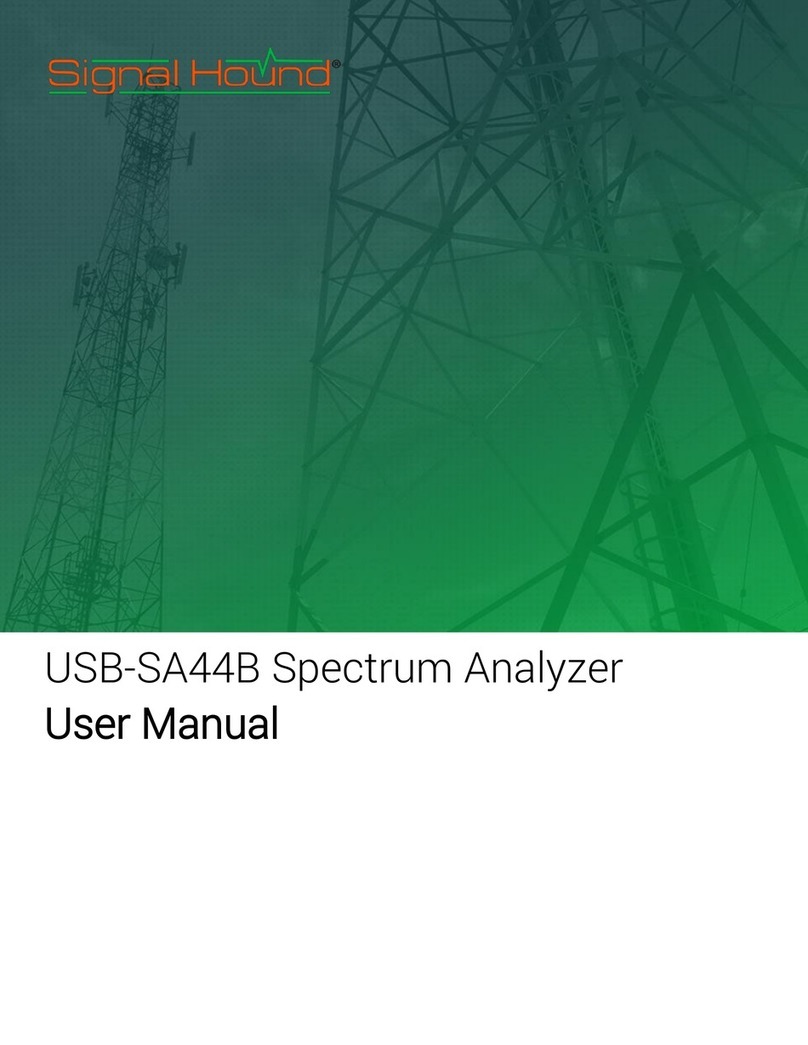
Signal Hound
Signal Hound SA44B User manual
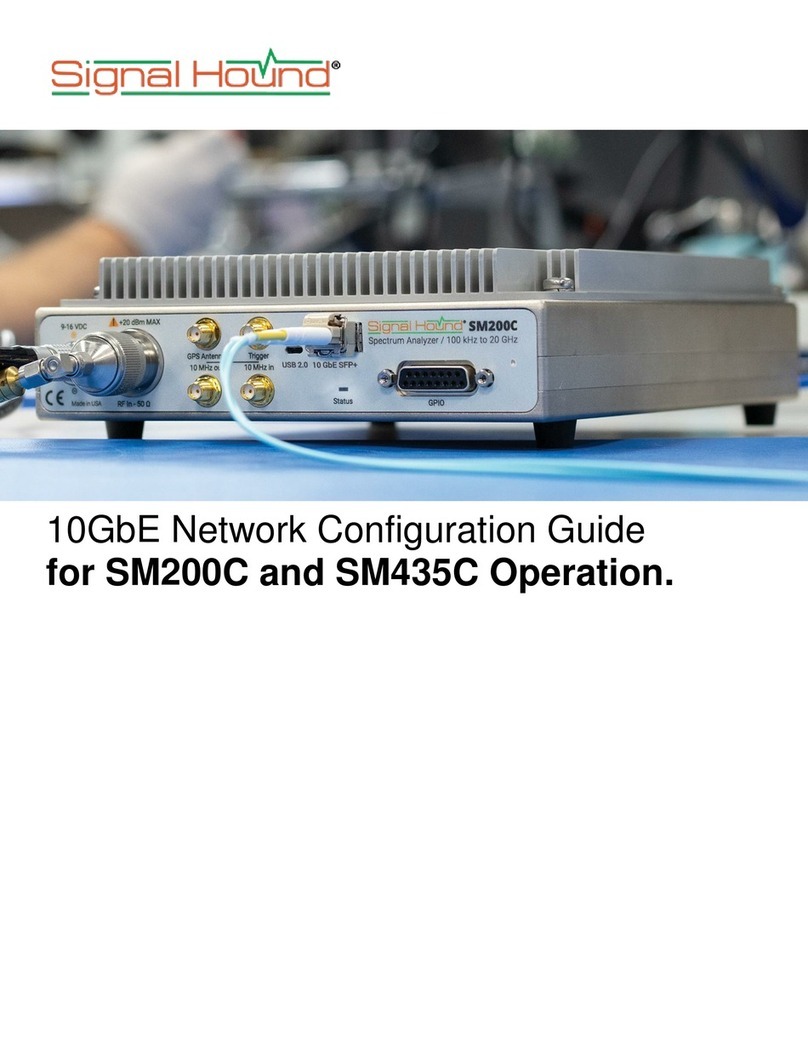
Signal Hound
Signal Hound SM200C User manual

Signal Hound
Signal Hound BB60A User manual

Signal Hound
Signal Hound SM200A User manual
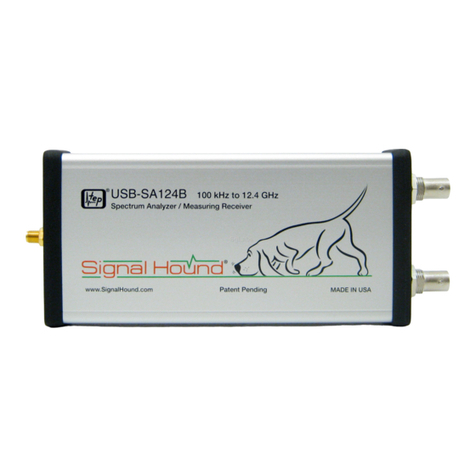
Signal Hound
Signal Hound USB-SA124B User manual

Signal Hound
Signal Hound USB-SA124B User manual

Signal Hound
Signal Hound BB60C User manual
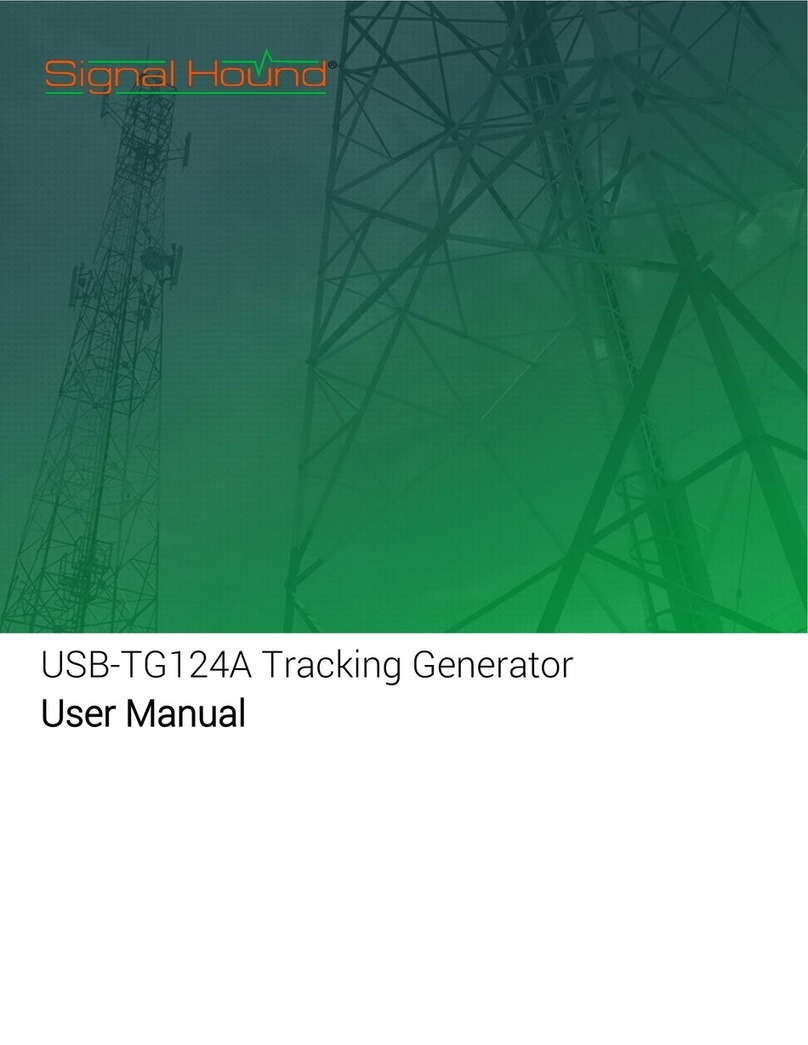
Signal Hound
Signal Hound USB-TG124A User manual

Signal Hound
Signal Hound SM200C User manual
